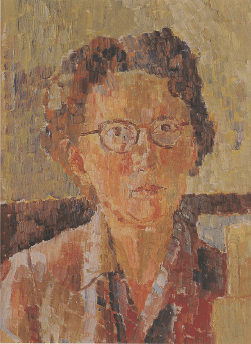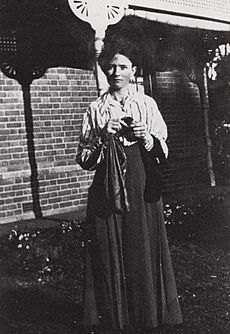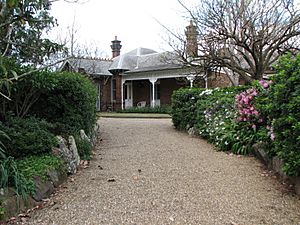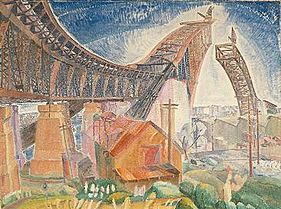Grace Cossington Smith facts for kids
Quick facts for kids
Grace Cossington Smith
|
|
|---|---|

Grace Cossington Smith, self-portrait, 1948, oil on cardboard, 39.5 x 30.7 cm, National Portrait Gallery.
|
|
| Born | 20 April 1892 Neutral Bay, New South Wales, Australia
|
| Died | 20 December 1984 (aged 92) |
| Nationality | Australian |
| Known for | Painting |
| Awards | Officer of the Order of the British Empire (OBE) (1973) Officer of the Order of Australia (AO) (1983) |
Grace Cossington Smith (20 April 1892 – 20 December 1984) was an Australian artist. She was a pioneer of modern art in Australia. She helped bring a style called Post-Impressionism to her home country. Her paintings are now in every major art gallery in Australia.
Contents
- About Grace Cossington Smith
- Famous Paintings
- Her Home, Cossington
- Art During World War I
- Sydney City Scenes
- Turramurra Landscapes
- Modern Art in Australia
- Sydney Harbour Bridge Art
- Art During World War II
- Australian Landscapes
- Travels and Interior Scenes
- Later Still Lifes
- Grace Cossington Smith Gallery
- See also
About Grace Cossington Smith
Grace Smith was born in Neutral Bay, Sydney. She was the second of five children. Her father, Ernest Smith, was a lawyer from London. Her mother, Grace, was the daughter of a church leader from Cossington, England.
The family moved to Thornleigh, New South Wales around 1890. Grace went to Abbotsleigh School for Girls from 1905 to 1909. There, she took art classes with Albert Collins and Alfred Coffey. From 1910 to 1911, she studied drawing with Antonio Dattilo Rubbo.
Between 1912 and 1914, Grace and her sister lived in England. They stayed with an aunt in Winchester. Grace also took drawing classes in Germany. During this time, she saw paintings by famous artists like Watteau.
After returning to Sydney in 1914, she continued painting classes with Dattilo Rubbo. She became very interested in new art ideas called "modernist theories." Her painting The Sock Knitter (1915) is thought to be Australia's first Post-Impressionist painting.
In 1920, Grace started using "Cossington" as her middle name. This was a tribute to her mother's family home.
Other artists like Roland Wakelin and Roy de Maistre greatly respected her work. She showed her art in many exhibitions. These included the Royal Art Society of New South Wales and the Society of Artists. She also exhibited with Thea Proctor's Contemporary Group and at the Macquarie Galleries.
Grace Cossington Smith's paintings are known for their unique style. She used individual, square brush strokes. She also used bright, unblended colors. She painted many scenes of Sydney, including landscapes, still lifes, and interiors. Some of her famous works include Kuringai Avenue (1943) and Fruit in the Window (1957). Her most famous painting is probably The Lacquer Room (1936). She became very well-known later in her life. In 1973, a large exhibition of her work traveled around Australia.
Famous Paintings
Grace Cossington Smith is one of Australia's most important artists of the 20th century. She was known for her modern paintings. These included a Sydney cafeteria, the Sydney Harbour Bridge as it was being built, and indoor scenes. In her later indoor scenes, yellow was often the main color. Many of her paintings show everyday suburban homes of her time. These included still lifes, doorways, and window sills. She also painted important events like the World Wars and the visit of the Prince of Wales to Sydney. These paintings give a wider view of what was happening in Australia and the world.
She used bright sunlight and amazing patterns of vibrant color. She added cool colors to shadows, which made her paintings feel energetic. She carefully placed brilliant brush strokes side by side to build up small squares of color. This technique helped her create shapes using color. She was one of the first Australian artists to be influenced by the European Post-Impressionist movement. This movement helped her break away from Australian Impressionism. Her works were very bold for her time. Her main interest was color, especially bright, shimmering colors filled with reflected sunlight. She supported modern art and developed her own special technique. People said she "did get a lot of criticism in the press, but she was very bold and she knew what she wanted."
Her Home, Cossington
Grace Cossington Smith grew up in her family's first house, called Cossington, in Neutral Bay, Sydney. In 1920, her family moved to another house. This house used to be a Quaker meeting-house. They also called this new home Cossington. It was located at 43 Ku-Ring-Gai Avenue, Turramurra. Grace lived there for most of her life. Both houses were named after her mother's original home, Cossington Hall, in Leicestershire, England. The house Cossington in Turramurra is now a heritage-listed building. This means it is protected because of its historical importance.
Art During World War I
Grace returned to Australia from a trip to England just before the First World War began. She supported the war effort. Her 1915 painting The Sock Knitter shows her sister knitting socks for the soldiers. This painting is often seen as the first Post-Impressionist painting in Australia. It shows a girl carefully knitting, with a ball of yarn next to her. When you think about the war, it's a powerful image of someone doing something small to help a bigger cause.
Grace also drew a series of cartoons that made fun of German army figures. These drawings were very different from her usual art style. Other works from this time include a drawing of Belgian refugees escaping the Germans. She also painted Reinforcements: troops marching (around 1917). These works show strong patterns and colors.
Sydney City Scenes
Cossington Smith painted the city of Sydney, its people, crowds, and places like restaurants or Martin Place. She often went to the city to sketch. She felt a bit shy about drawing in public. When the Prince of Wales visited Sydney, Grace went to record the event. She sketched the buildings around her. But she used her memory to paint the actual moment the Prince passed by. This was because it happened so quickly.
Her painting, The Prince (1920), accurately shows the scene. The Prince is being driven in his car through a street filled with a large crowd. It shows how warmly Australians welcomed the British royal family at that time. Australia was still very much part of the British Empire. She followed this with other paintings based on her Sydney sketches. Rushing (around 1922) shows crowds of people hurrying past. One woman looks surprised at the viewer. These paintings show that Sydney was already a busy city with many people going to and from work. Crowd shows a huge crowd, with almost everyone wearing hats, which was the fashion back then.
Turramurra Landscapes
Cossington Smith's paintings of the area around Turramurra show how Sydney's northern suburbs were growing. Her street scenes often showed roads going up and down hills. Her landscape paintings were often more successful when they were based around a road. Her painting, Eastern Road, Turramurra, shows a road very similar to many hilly roads in Turramurra. These roads have many dips and bends.
This picture tells us a lot about the lifestyle of people at the time. The houses seem to be on larger plots of land, not just small suburban yards. Trees are mostly along the side of the road, not close to the houses. The painting looks like a country town or village, not a city. The outer suburbs of Sydney still looked quite rural back then. These works, with their simple shapes and colors, are similar to other modernist artists' works from that time.
Modern Art in Australia
Cossington Smith was one of the first artists to bring Modernism to Australia. Her painting The Sock Knitter, from 1915, is very famous. It was called "the first Post-Impressionist painting to be shown in Australia."
Grace studied art in Australia and England. Her work was influenced by the modern paintings of Europe. She was interested in ideas that modern artists explored. These included:
- Studying how colors work together (color theory).
- Playing with the idea of depth in a painting (the picture plane).
- Using brush strokes to show feelings.
- Creating abstract compositions (arranging shapes and colors in new ways).
About The Sock Knitter, it is said that the way she made the painting look flat and used bright, broken colors with broad brush-strokes shows ideas from European painters like Cézanne, Matisse, and van Gogh. Even with these modern ideas, she became a founding member of the Australian Academy of Art. This group was actually against modern art.
Some of her paintings from around 1932–33 showed common interests of international artists. These paintings broke down objects into shapes based on their colors, like Cézanne did. They also used some Cubist ideas, changing how things looked. Her House With Trees, 1935, shows pink houses and unnatural blue bushes. She clearly changed the real colors and the way things looked in terms of perspective.
The Lacquer Room (1936) shows a view inside an Art Deco style café called the Soda Fountain. This café was in the David Jones department store in Sydney. The painting is very stylish, with pinks, yellows, and blues on the walls and floor. The people in the painting don't have much detail in their faces. But they look surprised and a bit snobby as they glance at the viewer. The bright, strong colors show the modern style. The painting is special because it has no shadows. The walls glow with bright, even light and color. Everything in the painting looks modern. This includes the trendy green table tops and the pink and red colors on the chairs and walls. Two unusual yellow modern lamps on the walls have an Art Deco look. The customers wear fur coats and stylish hats. This suggests it was a place for respectable, middle-class people. The waitresses wear bright green uniforms. The chairs have huge backs and tiny legs. This shows a new modern world of manufactured objects, not traditional wooden furniture.
Grace Cossington Smith also painted flower arrangements. These included daffodils, hippeastrums, and waratahs. She also painted her dog sleeping in cool purples and oranges. The painting was called Krinkley Kronks Sleeping, even though the dog's real name was Rex.
Sydney Harbour Bridge Art
Her paintings of the Sydney Harbour Bridge as it was being built are some of the best from that time. The bridge was a symbol of what Australians could achieve. Her first paintings of the bridge, like The Bridge in Curve, were done before the main arches were joined. To hide this, she focused more on painting the pylons (the tall towers) in her early bridge paintings. She liked painting the arches as they got closer to each other. She enjoyed the tension between the two sides. She did not paint the bridge after it was finished.
Even though the painting The Bridge in Curve (1930) was not accepted into an exhibition in 1930, it is now seen as one of Australia's best modern paintings. It shows the construction work continuing, with cranes on both sides of the bridge. Her very detailed drawing for the painting shows her eye for detail. It also shows her ability to capture a scene almost like a photograph. Smith did paint the Harbour Bridge completed in Great White Ship at Circular Quay. But in this painting, the focus is more on the ship in the front, not the bridge itself.
Art During World War II
Just like with the First World War, Grace also painted scenes related to the Second World War. She painted pictures showing Allied troops arriving in France. She also painted a dinner with Allied leaders at Yalta. And she painted a church service after the war ended to remember it. Church Interior (1941) shows a church scene where most men are missing, having gone to war. A later church scene, Thanksgiving Service, shows a church with the British Union Jack and the Red Ensign flags. This celebrated the victory in the war.
Several of her other paintings show large British flags. This reflected her own British background and love for her country. It also showed that many Australians still felt they were part of the British Empire. During the war, she was a warden. This meant she was in charge of helping people in Kur-ring-gai Avenue if there was any danger. She painted a meeting of wardens in Wardens' Meeting (1943). It shows people sitting on chairs, looking serious and perhaps talking quietly.
Dawn Landing (1944) shows troops and a tank getting off a ship after the Allied landings in France. This event marked the beginning of the end of Nazi rule in Europe. It was unusual for her to paint something she didn't see directly. Similarly, the painting Signing (1945) seems a bit different from her other work. It shows the signing of the peace treaty at Yalta. It shows seated figures who look like the three Allied world leaders. This event must have been very important for her to paint. She almost always painted scenes from her own experiences, not events happening far away.
Australian Landscapes
Grace painted outdoor scenes. She went on many trips to the countryside to paint whenever someone could take her. During her life, she visited several towns outside Sydney. She also visited the capital city, Canberra. She painted in the Blue Mountains, and in Moss Vale and Exeter.
In the late 1930s, she started a new style. This style was less influenced by modern art. It focused more on the light and color of Australia. It showed her own personal way of seeing the landscape. Her paintings show the olive green and brown colors of the Australian bush. She used visible brush strokes made up of many similar colors.
One of her best landscape works was a series of four large paintings. They were called Four panels for a screen: loquat tree, gum and wattle trees, waterfall, picnic in the gully (1929). The first two panels show trees in her yard. The last two show places further from her home: a waterfall and people having a picnic with a billy can in a gully. This shows the two parts of her landscape work. One part was about her immediate surroundings, like streets and trees. The other part was about places further away, where friends and family often took her to paint. These four paintings were ordered by someone. However, the order was cancelled. Because of this, Grace Smith never worked on a large art order again.
Travels and Interior Scenes
Grace visited England once with her sister between 1912 and 1914. She returned to Europe later, between 1948 and 1951. On her trips overseas, Grace saw a world different from her own. Yet, she painted it in her own unique style. On her second trip, she became very interested in English buildings. Besides sketches and drawings of cathedrals and buildings, she took many photos of indoor doorways and rooms inside houses. Her many sketchbooks show parts of her life. They are more relaxed and personal than her larger paintings. Sketchbooks can give more insight into an artist's daily life.
She started to focus more and more on these interior views. Ten room paintings were shown in her solo exhibition in 1947. Her large oil painting, Interior with verandah doors (1954), accurately shows her house. It has a large window and a door opening to the outside on the other side of the bed. This painting was the first of her larger room interior paintings. It prominently features yellow colors. She also experimented with views in mirrors. For example, in Interior with wardrobe mirror (1955), a mirror on an open wardrobe door is at a 45-degree angle. This allows the viewer to see the yard outside the house from the reflection in the glass. The sharp angles of these doors add energy and movement to the painting.
In all her later paintings, she used a unique style of square dabs of paint on the canvas. The colors were varied, but often leaned towards yellow. Many of her room interior paintings show the same room from different angles. Sometimes, they even show multiple views from a slightly different or the same angle. In some paintings, a door or window is the main focus. In others, the viewer sees the entire room. Her use of color has been compared to the work of Pierre Bonnard. However, she said she found Cézanne a more important influence. Her style of many multi-colored brush strokes was used not only in her interior views, but also in her still lifes.
Later Still Lifes
Grace's later still lifes explore how different colors can be put together to create a unified feeling. She painted many still lifes of fruit, jugs, and vases. These often included glimpses of fabric and parts of the room behind them. Her style used many individual, choppy, square brush strokes to make up the whole. The colors varied, but still gave an overall yellowish feel. She had a strong sense of perspective and a great eye for detail. She made the objects look solid and real in three-dimensional space.
Still life with red vase (1962) shows a bold red vase. It stands out against a background made from its opposite color, green, or at least, greenish-yellow. Another jug to the right blends in with the background. But the red jug is clearly placed on the table. Still life with white cup and saucer (1971), one of her last paintings, shows several jugs in green, red, and yellow. They all look very solid. A lovely white cup and saucer are nearby. After this painting, she became very weak and could no longer paint large works.
From 1914, Grace painted in a small studio hut in the garden, beyond the tennis lawn. Her mother died in 1931, and her father in 1938. Grace then became the head of the Cossington household. A larger, well-lit studio was added to the house, next to her large bedroom.
Awards and Death
In 1973, Grace Cossington Smith was made an Officer of the Order of the British Empire (OBE). For her contributions to Australian art, she was appointed an Officer of the Order of Australia in 1983. The Governor of New South Wales visited Grace Cossington Smith in her nursing home to give her this honor.
Grace Cossington Smith died on 20 December 1984 in Roseville, New South Wales.
Grace Cossington Smith Gallery
The Grace Cossington Smith Gallery opened in the Abbotsleigh Senior School in Wahroonga in 2013. This gallery is located in Vindin House, which used to be a boarding house for girls. The gallery hosts different art exhibitions throughout the year. On the second floor is the Year 12 art studio, where students study art for their HSC exams. The gallery is open to the public from Monday to Saturday, from 9 am until 5 pm.
See also
 In Spanish: Grace Cossington Smith para niños
In Spanish: Grace Cossington Smith para niños






